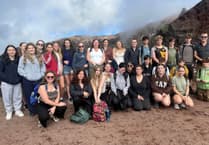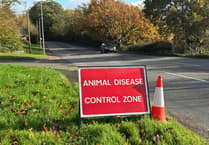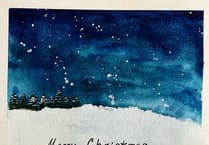TODAY, August 14, is the anniversary of the disastrous Great Fire of Crediton which saw 460 houses destroyed in Crediton High Street and the “West Town” area of Crediton during the 10 hours the fire raged.
The fire broke out at about 11am on the Sunday morning in the year 1743, roughly where Lloyds Bank now stands.At least 16 people lost their lives with more than 2,000 made homeless when the homes and several inns and hotels in the market area were destroyed.
A few weeks before the Great Fire the Strode map of Crediton was made and following the fire, an addition was made to the map to show where the fire started.
Crediton Area History and Museum Society member Keith Mortimer explained that Samuel Strode (a wealthy London merchant who was Lord of the Manor at the time), had commissioned the map to record all the encroachments that had been made out into the high street.
He added: “Crediton Museum now has a new copy of the map on display next to the model on the mezzanine in the Old Town Hall.
“It can be viewed when the Museum is open and is worth a look.“The map extends from about where Crediton Auto Services stands in Union Road to just west of the Red House at St Lawrence Green and is two metres long.“
The map extract and other photos from our archive can be viewed on our ‘Facebook’ page ‘Crediton Museum’.”
SECOND LARGEST
At the time, the Great Fire of Crediton was the second largest fire in the country, second only to the Great Fire of London.Damage totalled £50,000 with many traders losing valuable stock.
The maltsters of Crediton lost 1,000 bushels of their malt, leaving many of them in financial ruin. They later petitioned for a return on the duty they had already paid on the lost malt.
Their appeal continued for at least 25 years after the event but it has not been able to establish whether or not they were finally granted the tax refund!
A poem: “The Conflagration” published in the same year and written to “a friend” of the author describes the fire in some detail and other accounts describe the devastation: “There is not a house standing in all the town from ‘The Sign of the Lamb’ to the uttermost end of the Green, which is half-a-mile, together with all the backlets, lanes, byways, linhays, gardens and apple-trees, the apples roasting as they hung.” (The Universal Spectator).
In his sermon the following Sunday (August 21, 1743) Micaiah Towgood, the pastor at Crediton since 1737, declared that the fire was no chance occurrence: “it happened by the will of God”.He published a book of his sermons which includes a short account of the fire and in one sermon referred to the “drunkenness and general disorder at the St Lawrence Fair” a few days before the fire as the reason for Divine retribution.
John Wesley, visiting Crediton a few months after the fire, noted in his diary: “Before eight (am) we reached Crediton (or Kirton), or rather the ruins of it; for the houses on both sides were all in ashes for several hundred yards.“Lighting on a serious woman, I asked: ‘Are the people of this place now warned to seek God?’
“She answered: ‘Although some of them perished in the flames, the rest are just as they were before, cursing, swearing, drinking, playing and making merry, without God in their thoughts.’
“She added: ‘No longer ago than Thursday last the men who were rebuilding one of the houses were bitterly cursing and swearing one at another, and two of them above the rest, when an arch they were under fell, and crushed these two, with all their bones in pieces’.”
A second fire consumed many of the houses rebuilt after the former fire, together with the market-house and shambles. Other large fires occurred in 1766, 1769 and 1772.
Crediton Area History and Museum Society (CAHMS) holds an exhibition in its High Street museum each summer.
EXHIBITION
It is currently planning its Summer 2023 exhibition, which will be about the Great Fire of Crediton in 1743.
The Society is putting together a book to accompany the exhibition.
A spokesperson for the Society explained: “Some people will know about the very detailed map showing the High Street and the western part of the town as it looked immediately before the fire.
“Our book will use the map, together with a clutch of previously-unreported documents, to present a picture of life in Crediton in the years before the fire. We’ve also got some dramatic first-hand accounts of the fire itself. And we’re collecting evidence of how local families strove to rebuild their lives, their homes and their businesses in the following years.
“Our book has many stories to tell. Stories of how people made their living in a surprising range of trades. Alongside tales of wealth, debt and disputed inheritances we have a clockmaker who went on to make the first known clock in the United States; a schoolteacher who became a renowned expert in the science of navigation; and the story of a highway robbery. The book will include copies of the three separate pages of the 1743 map and a range of other illustrations.
“We’re offering you the opportunity to subscribe to the book in advance. Each subscriber pays for their copy up-front; and their name will be included in the book as an acknowledgement of their support. The subscriber price is £15 a copy.
“If you would like to subscribe, or simply to find out more, email us at [email protected] .”





Comments
This article has no comments yet. Be the first to leave a comment.